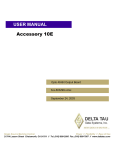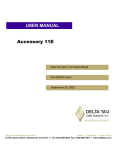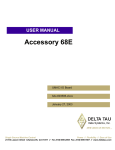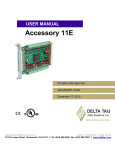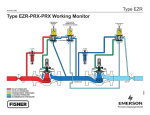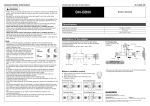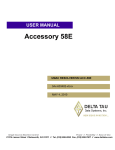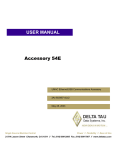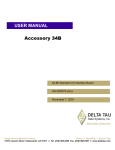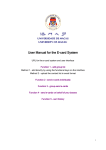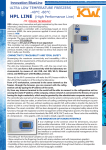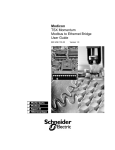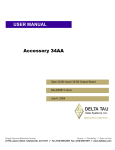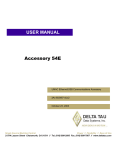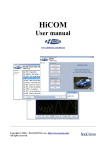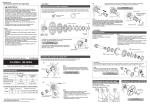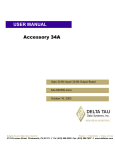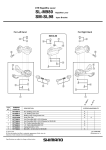Download ^1 USER MANUAL ^2 Accessory 3E
Transcript
^1 USER MANUAL ^1 USER MANUAL ^2 Accessory 3E ^3 The 144-Bit I/O Board ^4 3Ax-602811-xUxx ^5 October 15, 2003 Single Source Machine Control Power // Flexibility // Ease of Use 21314 Lassen Street Chatsworth, CA 91311 // Tel. (818) 998-2095 Fax. (818) 998-7807 // www.deltatau.com Copyright Information © 2003 Delta Tau Data Systems, Inc. All rights reserved. This document is furnished for the customers of Delta Tau Data Systems, Inc. Other uses are unauthorized without written permission of Delta Tau Data Systems, Inc. Information contained in this manual may be updated from time-to-time due to product improvements, etc., and may not conform in every respect to former issues. To report errors or inconsistencies, call or email: Delta Tau Data Systems, Inc. Technical Support Phone: (818) 717-5656 Fax: (818) 998-7807 Email: [email protected] Website: http://www.deltatau.com Operating Conditions All Delta Tau Data Systems, Inc. motion controller products, accessories, and amplifiers contain static sensitive components that can be damaged by incorrect handling. When installing or handling Delta Tau Data Systems, Inc. products, avoid contact with highly insulated materials. Only qualified personnel should be allowed to handle this equipment. In the case of industrial applications, we expect our products to be protected from hazardous or conductive materials and/or environments that could cause harm to the controller by damaging components or causing electrical shorts. When our products are used in an industrial environment, install them into an industrial electrical cabinet or industrial PC to protect them from excessive or corrosive moisture, abnormal ambient temperatures, and conductive materials. If Delta Tau Data Systems, Inc. products are directly exposed to hazardous or conductive materials and/or environments, we cannot guarantee their operation. Accessory 3E Table of Contents INTRODUCTION .....................................................................................................................................................1 HARDWARE SETUP ...............................................................................................................................................3 ACC-3E Board Layout............................................................................................................................................3 ACC-3E Connectors................................................................................................................................................4 ACC-3E 48/96/144-I/O Board Jumpers ..................................................................................................................4 E1-E4: I/O Gate Address Select Jumpers..........................................................................................................4 E1-E4: I/O Gate Address Select Jumpers..........................................................................................................4 USING ACC-3E WITH TURBO UMAC................................................................................................................5 UMAC-Turbo Memory Mapping for ACC-3E .......................................................................................................5 Control Register ......................................................................................................................................................5 Direction Control Bits ........................................................................................................................................6 Register Select Control Bits................................................................................................................................6 Control Word Setup Example .............................................................................................................................6 Accessory 3E I/O M-Variables for UMAC Turbo..................................................................................................7 UMAC Turbo Closed Loop Control Using ACC-3E..............................................................................................8 USING ACC-3E WITH UMAC-MACRO ..............................................................................................................9 MACRO Station I/O Node Transfer Addresses...................................................................................................9 PMAC2 Ultralite I/O Node Addresses..............................................................................................................10 PMAC2 Turbo Ultralite I/O Node Addresses ...................................................................................................10 MACRO I/O Software Setings..............................................................................................................................11 ACC-3E Setup with MACRO ...............................................................................................................................16 Reading and Writing to Node Addresses ..............................................................................................................17 Example:...........................................................................................................................................................17 Example Setup: .................................................................................................................................................17 Active Nodes for Compact MACRO I/O Station ...............................................................................................18 PMAC2 Ultralite Example M-Variable Definitions..............................................................................................19 PMAC2 TURBO Ultralite Example M-Variable Definitions ...............................................................................20 Example 1: 48 Inputs 48 Outputs Using 3×16-Bit Transfers ...............................................................................21 Example 2: 48 Inputs 48 Outputs Using 1×24-Bit Transfers ...............................................................................22 Example 3: 36 Inputs 36 Outputs Using 1×72-Bit Transfer ................................................................................23 ACC-3E 144-I/O PIGGYBACK BOARD HEADER DESCRIPTIONS ............................................................25 J4 (50-Pin Header) I/O Connector Description ...............................................................................................25 J5 (50-Pin Header) I/O Connector Description ...............................................................................................26 J6 (50-Pin Header) I/O Connector Description ...............................................................................................27 J7 (50-Pin Header) I/O Connector Description ...............................................................................................28 J8 (50-Pin Header) I/O Connector Description ...............................................................................................29 J9 (50-Pin Header) I/O Connector Description ...............................................................................................30 J10 (26-Pin Header) I/O Connector Description .............................................................................................32 P1 (96-Pin Header) (Option A Required)........................................................................................................33 Table of Contents i Accessory 3E ii Table of Contents Accessory 3E INTRODUCTION The PMAC Accessory 3E is a general-purpose I/O board to the PMAC2 Ultralite via the MACRO Station. ACC-3E provides up to 144-bits lines of digital I/O. The actual I/O Reads are carried out using M-variables like other tradition PMAC products. ACC-3E is one of the series of MACRO Stack accessories designed to transfer data to the MACRO-Station through its JEXP port pins plugged directly into the stack. The other boards in the family of MACRO accessories are: ACC-1E ACC-2E ACC-3E ACC-4E ACC-6E Introduction 2-axis Expansion Card 4-Axis Expansion Card up to 144-bits TTL level I/O 48-bits optically isolated I/O 8-16 channels 12-bit A/D Converters Accessory 3E 2 Introduction Accessory 3E HARDWARE SETUP The ACC-3E uses expansion port memory locations defined by the type of PMAC (3U Turbo or MACRO Station) it is directly communicating to. These memory locations are typically used with other Delta Tau 3U I/O accessories such as: ACC-4E ACC-6E 24 inputs and 24 outputs, low power, all optically isolated 16 channels 12-bit ADC All of these accessories have settings which tell them where the information is to be processed at either the PMAC 3U Turbo or the MACRO Station. 3U Turbo PMAC Memory Locations MACRO Station Memory Locations $078800 $078900 $078A00 $078B00 $FFC0 $FFC8 $FFD0 $FFD8 The ACC-3E has a set of jumers (E1 through E4) telling it where to process its data Once the information is at these locations, we can process the binary word in the encoder conversion table to use for servo loop closure. Proper setting of the dip-switches ensures all of the JEXP boards used in the application do not interfere with each other. ACC-3E Board Layout Hardware Setup 3 Accessory 3E ACC-3E Connectors J1: (JEXP_A) 40-pin header for connection to piggyback board(s) J2: (JEXP_B) 40-pin header for connection to piggyback board(s) J3: (JEXP_C) 28-pin header for connection to piggyback board(s) J4: 50-pin IDC header for connection of I/O00 to I/O23 to Opto-22 G4PB24 or equivalent I/O board with straight-across connector (Option A required) J5: 50-pin IDC header for connection of I/O24 to I/O47 to Opto-22 G4PB24 or equivalent I/O board with straight-across connector (Option A required) J6: 50-pin IDC header for connection of I/O48 to I/O71 to Opto-22 G4PB24 or equivalent I/O board with straight-across connector (Option B required) J7: 50-pin IDC header for connection of I/O72 to I/O95 to Opto-22 G4PB24 or equivalent I/O board with straight-across connector (Option B required) J8: 50-pin IDC header for connection of I/O96 to I/O119 to Opto-22 G4PB24 or equivalent I/O board with straight-across connector (Option C required) J9: 50-pin IDC header for connection of I/O120 to I/O143 to Opto-22 G4PB24 or equivalent I/O board with straight-across connector (Option C required) J10: 26-pin IDC header for connection of optically isolated outputs for I/O120 to I/O127; and optically isolated inputs for I/O128 to I/O143 (Option C1 or C2 required). P1: 96-pin DIN connector for connection of I/O00 to I/O47 (Option A required) TB1: 2-pin terminal block for 5V power supply ACC-3E 48/96/144-I/O Board Jumpers UMAC TURBO E1 E2 E3 E4 1-2 1-2 1-2 1-2 $FFC0-$FFC7 $FFC8-$FFCF $FFD0-$FFD7 $FFD8-$FFDF $078800-$078807 $078900-$078907 $078A00-$078A07 $078B00-$078B07 E4 UMAC MACRO E3 Setting E2 Jumper E1 E1-E4: I/O Gate Address Select Jumpers Note: Only one of E1 to E4 may be ON on any board. If more than one of these boards is used in a given UMAC-MACRO or UMAC Turbo, each must have a different jumper ON.) E1-E4: I/O Gate Address Select Jumpers Jump pins 1 and 2 to latch inputs on the SERVO clock Jump pins 2 and 3 to latch inputs on the PHASE clock (default) 4 Hardware Setup Accessory 3E USING ACC-3E WITH TURBO UMAC For the UMAC-Turbo, the ACC-3E can be used for either general purpose I/O or as latched inputs for servo loop position or velocity feedback. The registers used for general I/O use are 8-bit registers and the user will define three 8-bit registers for each 24-bit I/O port. To use the ACC-3E for closed loop servo data the user must setup various I-variables for the encoder conversion table and power-on position. The encoder conversion table is setup using variables I8000 through I8192. Each variable is an entry in the conversion table and it’s setup is described in the TURBO PMAC Software Reference Manual. UMAC-Turbo Memory Mapping for ACC-3E The Dalta Tau I/O Gate used on the ACC-3E is an 8-bit processor and therefore the memory mapping to the I/O bits is processed as 8-bit words at the Turbo UMAC. Using this simple scheme the user could process up to 576 (144×4) bits of data for general purpose I/O. Jumper E1 Jumper E2 Jumper E3 Jumper E4 Description Y:$078800,0,8 Y:$078801,0,8 Y:$078802,0,8 Y:$078803,0,8 Y:$078804,0,8 Y:$078805,0,8 Y:$078807,0,8 Y:$078800,8,8 Y:$078801,8,8 Y:$078802,8,8 Y:$078803,8,8 Y:$078804,8,8 Y:$078805,8,8 Y:$078807,8,8 Y:$078800,16,8 Y:$078801,16,8 Y:$078802,16,8 Y:$078803,16,8 Y:$078804,16,8 Y:$078805,16,8 Y:$078807,16,8 Y:$078900,0,8 Y:$078901,0,8 Y:$078902,0,8 Y:$078903,0,8 Y:$078904,0,8 Y:$078905,0,8 Y:$078907,0,8 Y:$078900,8,8 Y:$078901,8,8 Y:$078902,8,8 Y:$078903,8,8 Y:$078904,8,8 Y:$078905,8,8 Y:$078907,8,8 Y:$078900,16,8 Y:$078901,16,8 Y:$078902,16,8 Y:$078903,16,8 Y:$078904,16,8 Y:$078905,16,8 Y:$078907,16,8 Y:$078A00,0,8 Y:$078A01,0,8 Y:$078A02,0,8 Y:$078A03,0,8 Y:$078A04,0,8 Y:$078A05,0,8 Y:$078A07,0,8 Y:$078A00,8,8 Y:$078A01,8,8 Y:$078A02,8,8 Y:$078A03,8,8 Y:$078A04,8,8 Y:$078A05,8,8 Y:$078A07,8,8 Y:$078A00,16,8 Y:$078A01,16,8 Y:$078A02,16,8 Y:$078A03,16,8 Y:$078A04,16,8 Y:$078A05,16,8 Y:$078A07,16,8 Y:$078B00,0,8 Y:$078B01,0,8 Y:$078B02,0,8 Y:$078B03,0,8 Y:$078B04,0,8 Y:$078B05,0,8 Y:$078B07,0,8 Y:$078B00,8,8 Y:$078B01,8,8 Y:$078B02,8,8 Y:$078B03,8,8 Y:$078B04,8,8 Y:$078B05,8,8 Y:$078B07,8,8 Y:$078B00,16,8 Y:$078B01,16,8 Y:$078B02,16,8 Y:$078B03,16,8 Y:$078B04,16,8 Y:$078B05,16,8 Y:$078B07,16,8 I/O bits 0-7 (J4) I/O bits 8-15(J4) I/O bits 16-23 (J4) I/O bits 24-31 (J5) I/O bits 32-39(J5) I/O bits 40-47 (J5) Control Word I/O bits 0-7 (J6) I/O bits 8-15(J6) I/O bits 16-23 (J6) I/O bits 24-31 (J7) I/O bits 32-39(J7) I/O bits 40-47 (J7) Control Word I/O bits 0-7 (J8) I/O bits 8-15(J8) I/O bits 16-23 (J8) I/O bits 24-31 (J9) I/O bits 32-39(J9) I/O bits 40-47 (J9) Control Word Because the data processed at these I/O Gate Arrays are extremely fast, the user were to map the machine I/O to the ACC-3E memory locations, they could do ao bit wise or using 8-bit words. Control Register The control register at address {Base + 7} permits the configuration of the IOGATE IC to a variety of applications. The control register consists of eight write/read-back bits – Bits 0 - 7. The control register consists of two sections; Direction Control and Register Select. The direction control allows the user to set his/her input bytes to be read only. One of the advantages of the IOGATE IC is that we give the user the ability to define the bits as inputs or outputs. This “control” mechanism allows the user to ensure the inputs will always be read properly. Our traditional I/O accessories always define the inputs and outputs by hardware. The register select bits allow the user to define the input or output bytes inversion control or the latching input features. Using Acc-3E with Turbo UMAC 5 Accessory 3E Direction Control Bits Bits 0 to 5 of the control register simply control the direction of the I/O for the matching numbered data register. That is, Bit n controls the direction of the I/O at {Base + n}. A value of 0 in the control bit (the default) permits a write operation to the data register, enabling the output function for each line in the register. Enabling the output function does not prevent the use of any or all of the lines as inputs, as long as the outputs are off (non-conducting). A value of 1 in the control bit does not permit a write operation to the data register, disabling the output, reserving the register for inputs. For example, a value of 1 in Bit 3 disables the write function into the data register at address {Base + 3}, ensuring that lines IO24 - IO31 can always be used as inputs. Register Select Control Bits Bits 6 and 7 of the control register together select which of 4 possible registers can be accessed at each of the addresses {Base + 0} through {Base + 5}. They also select which of 2 possible registers can be selected at {Base + 6}. The following table explains how these bits select registers: Bit 7 Bit 6 Combined Value 0 0 1 1 0 1 0 1 0 1 2 3 {Base + 0} to {Base + 5} Register Selected {Base + 6} Register Selected Data Register Setup Register 1 Setup Register 2 Setup Register 3 Data Register Setup Register n. a. n. a. In a typical application, non-zero combined values of Bits 6 and 7 are only used for initial configuration of the IC. These values are used to access the setup registers at the other addresses After the configuration is finished, zeros are written to both Bits 6 and 7, so the data registers at the other registers can be accessed. Control Word Setup Example The user will need to setup the control words for the IO card at power up. A simple plc could be written to setup the control word properly could accomplish this task. For this example, we will be setting up one ACC-3E (IC0 48in/48out) and one ACC4E (IC1 - 24in/24out) Control Word for ACC-3E (M2007->Y:$078807,0,8) Hex ($) Binary Bit 0 0 7 0 6 1 5 1 4 7 1 3 1 2 1 1 1 0 Bits 0-7 are read only Bits 8-15 are read only Bits 16-23 are read only Register Select M2000->Y:$078800,0,8 6 Bits 24-31 read only Bits 32-39 read only Bits 40-47 read only ;I/O bits 0-7 (port A IC0) Using Acc-3E with Turbo UMAC Accessory 3E M2001->Y:$078801,0,8 M2002->Y:$078802,0,8 M2003->Y:$078803,0,8 M2004->Y:$078804,0,8 M2005->Y:$078805,0,8 M2006->Y:$078806,0,8 M2007->Y:$078807,0,8 ;I/O bits 8-15 (port A IC0) ;I/O bits 16-23 (port A IC0) ;I/O bits 0-7 (port B IC0) ;I/O bits 8-15 (port B IC0) ;I/O bits 16-23 (port B IC0) ;register selected ;control register M2008->Y:$078800,8,8 M2009->Y:$078801,8,8 M2010->Y:$078802,8,8 M2011->Y:$078803,8,8 M2012->Y:$078804,8,8 M2013->Y:$078805,8,8 M2014->Y:$078806,8,8 M2015->Y:$078807,8,8 ;I/O bits 0-7 (port A IC1) ;I/O bits 8-15 (port A IC1) ;I/O bits 16-23 (port A IC1) ;I/O bits 0-7 (port B IC1) ;I/O bits 8-15 (port B IC1) ;I/O bits 16-23 (port B IC1) ;register selected ;control register M2016->Y:$078800,16,8 M2017->Y:$078801,16,8 M2018->Y:$078802,16,8 M2019->Y:$078803,16,8 M2020->Y:$078804,16,8 M2021->Y:$078805,16,8 M2022->Y:$078806,16,8 M2023->Y:$078807,16,8 ;I/O bits 0-7 (port A IC2) ;I/O bits 8-15 (port A IC2) ;I/O bits 16-23 (port A IC2) ;I/O bits 0-7 (port B IC2) ;I/O bits 8-15 (port B IC2) ;I/O bits 16-23 (port B IC2) ;register selected ;control register M2007->Y:078C07,0,8 M2015->Y:078C07,8,8 M2023->Y:078C07,16,8 ;control word for $78C00,0,8 - $78C05,0,8 ;control word for $78C00,8,8 - $78C05,8,8 ;control word for $78C00,16,8 -$78C05,16,8 ;**** PLC to initialize OPEN PLC 1 CLEAR M2007=$3F M2015=$00 M2023=$07 DIS PLC1 CLOSE read/write I/O bits **** ;define bits 0-23 and 24-47 as inputs (ACC-3E) ;define bits 0-23 and 24-47 as outputs (ACC-3E) ;define bits 0-23 as inputs and bits 24-47 as outputs (ACC-4E) Accessory 3E I/O M-Variables for UMAC Turbo The following is a list of suggested M-variables for the default jumper settings is provided. You may assign any M-variables to these addresses. For this example we are assuming 24 inputs and 24 outputs. The user may make these M-variable definitions and use them as general purpose I/O for their PLC’s or motion programs. M7000->Y:$079C00,0,1 M7001->Y:$079C00,1,1 M7002->Y:$079C00,2,1 M7003->Y:$079C00,3,1 M7004->Y:$079C00,4,1 M7005->Y:$079C00,5,1 M7006->Y:$079C00,6,1 M7007->Y:$079C00,7,1 M7008->Y:$079C01,0,1 M7009->Y:$079C01,1,1 M7010->Y:$079C01,2,1 M7011->Y:$079C01,3,1 M7012->Y:$079C01,4,1 M7013->Y:$079C01,5,1 Input Input Input Input Input Input Input Input Input Input Input Input Input Input Using Acc-3E with Turbo UMAC 0 1 2 3 4 5 6 7 8 9 10 11 12 13 M7024->Y:$079C03,0,1 M7025->Y:$079C03,1,1 M7026->Y:$079C03,2,1 M7027->Y:$079C03,3,1 M7028->Y:$079C03,4,1 M7029->Y:$079C03,5,1 M7030->Y:$079C03,6,1 M7031->Y:$079C03,7,1 M7032->Y:$079C04,0,1 M7033->Y:$079C04,1,1 M7034->Y:$079C04,2,1 M7035->Y:$079C04,3,1 M7036->Y:$079C04,4,1 M7037->Y:$079C04,5,1 Output Output Output Output Output Output Output Output Output Output Output Output Output Output 0 1 2 3 4 5 6 7 8 9 10 11 12 13 7 Accessory 3E M7014->Y:$079C01,6,1 M7015->Y:$079C01,7,1 M7016->Y:$079C02,0,1 M7017->Y:$079C02,1,1 M7018->Y:$079C02,2,1 M7019->Y:$079C02,3,1 M7020->Y:$079C02,4,1 M7021->Y:$079C02,5,1 M7022->Y:$079C02,6,1 M7023->Y:$079C02,7,1 Input Input Input Input Input Input Input Input Input Input 14 15 16 17 18 19 20 21 22 23 M7038->Y:$079C04,6,1 M7039->Y:$079C04,7,1 M7040->Y:$079C05,0,1 M7041->Y:$079C05,1,1 M7042->Y:$079C05,2,1 M7043->Y:$079C05,3,1 M7044->Y:$079C05,4,1 M7045->Y:$079C05,5,1 M7046->Y:$079C05,6,1 M7047->Y:$079C05,7,1 Output Output Output Output Output Output Output Output Output Output 14 15 16 17 18 19 20 21 22 23 ;****** Sample E-Stop PLC ***** ; This PLC will abort all motion programs and kill the bus voltage to ; the motors when E-stop is depressed. When E-Stop button in pulled out ; the motors will servo to actual position (<ctrl> A command) after ; allowing 5 seconds for proper bus voltage. ; ; ; ; P7000 M7000 M7024 I5111 used used used used as a Latch variable Emergancy Stop Input as Main Contact for main AC for Bus Voltage as count down timer OPEN PLC 5 CLEAR IF (M7000=1 and P7000=0) CMD^A I5111=500*8388608/I10 WHILE (I5111>0) ENDWHILE CMD^K M7024=0 P7000=1 Endif IF (M7000=0 and P7000=1) M7024=1 I5111=5000*8388608/I10 WHILE (I5111>0) ENDWHILE CMD^A P7000=0 Endif ;emergancy stop condition ;global motion program abort ;500 msec delay for deceleration ;kill all axes ;turn off BUS voltage ;latch input ;enable BUS volatge ;5000 msec delay for bus voltage ;close loop for all servos ;latch input close UMAC Turbo Closed Loop Control Using ACC-3E The ACC-3E data can also be used for closed loop control. The encoder conversion table at the UMACTurbo will have to be modified to use the data for closed loop control. Example: E2 is jumpered on the ACC-3E to select the I/O Gate address (Y:$078900-Y:$78907) Set: I8000 =$F78900 ;turbo location $3501 process Y:$078900 as parallel 3U format I8001 =$018000 ;turbo location $3502 for 24-bit Y register The user can then set Ix03 and Ix04 to $3502 to use the data for parallel feedback. 8 Using Acc-3E with Turbo UMAC Accessory 3E USING ACC-3E WITH UMAC-MACRO A fundamental understanding of the MACRO Station I/O transfer is needed to set up the MACRO I/O family of accessories. The MACRO station typically will have up to eight axis nodes (0, 1, 4, 5, 8, 9, 12, and 13) and up to six I/O transfer nodes (2, 3, 6, 7, 10, and 11). There are three types of I/O transfers allowed to send the information to the Ultralite from the MACRO-Station: 48-bit transfer, 24-bit transfer, and 72-bit transfer. The PMAC2 Ultralite and the MACRO-Station enable the user to transfer 72 bits per I/O node. For a multi Master system, 432 bits (6×72) of data may be transferred for each Master (Ultralite) in the ring. If only one Master is used in the ring, node 14 could be used for I/O transfer, which would give us 504 bits (7×72) of I/O transfer data. For all MACRO-Station I/O accessories, the information is transferred to or from the accessory I/O Gate to the MACRO-Station CPU Gate 2B. Information from the MACRO-Station Gate 2B is then read or written directly to the MACRO IC on the Ultralite. Once the information is at the Ultralite, it can be used in the users application motion programs or PLC programs. Ultralite MACRO IC MACRO Station Gate 2B I/O Accessory Gate Each I/O board has jumper and software settings to select the I/O transfer memory locations at both the I/O transfer Gate and the MACRO transfer addresses. These jumpers and software settings are discussed in this manual. MACRO I/O Gate Locations for ACC3E and ACC4E $FFC0, $FFC2, $FFC4 $FFC8, $FFCA, $FFCC $FFD0, $FFD2, $FFD4 $FFD8, $FFDA, $FFDC MACRO Station I/O Node Transfer Addresses Node(s) Node 24-bit: Transfer Addresses Node 16-bit (upper 16 bits): Transfer Addresses 2 3 6 7 10 11 X:$C0A0 X:$C0A4 X:$C0A8 X:$C0AC X:$C0B0 X:$C0B4 X:$C0A1, X:$C0A2, X:$C0A3 X:$C0A5, X:$C0A6, X:$C0A7 X:$C0A9, X:$C0AA, X:$C0AB X:$C0AD, X:$C0AE, X:$C0AF X:$C0B1, X:$C0B2, X:$C0B3 X:$C0B5, X:$C0B6, X:$C0B7 Using Acc-3E with Turbo UMAC 9 Accessory 3E PMAC2 Ultralite I/O Node Addresses Node Node 24-bit: Transfer Addresses Node 16-bit (upper 16 bits): Transfer Addresses 2 3 6 7 10 11 X:$C0A0 X:$C0A4 X:$C0A8 X:$C0AC X:$C0B0 X:$C0B4 X:$C0A1, X:$C0A2, X:$C0A3 X:$C0A5, X:$C0A6, X:$C0A7 X:$C0A9, X:$C0AA, X:$C0AB X:$C0AD, X:$C0AE, X:$C0AF X:$C0B1, X:$C0B2, X:$C0B3 X:$C0B5, X:$C0B6, X:$C0B7 PMAC2 Turbo Ultralite I/O Node Addresses MACR O IC Node User Node Node 24-bit Transfer Addresses Node 16-bit (upper 16 bits) Transfer Addresses (IC0 ) 2 (IC0) 3 (IC0) 6 (IC0) 7 (IC0) 10 (IC0) 11 (IC1) 2 (IC1) 3 (IC1) 6 (IC1) 7 (IC1) 10 (IC1) 11 (IC2 ) 2 (IC2) 3 (IC2) 6 (IC2) 7 (IC2) 10 (IC2) 11 (IC3) 2 (IC3) 3 (IC3) 6 (IC3) 7 (IC3) 10 (IC3) 11 2 3 6 7 10 11 18 19 22 23 26 27 34 35 38 39 42 43 50 51 54 55 58 59 X:$078420 X:$078424 X:$078428 X:$07842C X:$078430 X:$078434 X:$079420 X:$079424 X:$079428 X:$07942C X:$079430 X:$079434 X:$078420 X:$07A424 X:$07A428 X:$07A42C X:$07A430 X:$07A434 X:$07B420 X:$07B424 X:$07B428 X:$07B42C X:$07B430 X:$07B434 X:$078421, X:$078422, X:$078423 X:$078425, X:$078426, X:$078427 X:$078429, X:$07842A, X:$07842B X:$07842D, X:$07842E, X:$07842F X:$078431, X:$078432, X:$078433 X:$078435, X:$078436, X:$078437 X:$079421, X:$079422, X:$079423 X:$079425, X:$079426, X:$079427 X:$079429, X:$07942A, X:$07942B X:$07942D, X:$07942E, X:$07942F X:$079431, X:$079432, X:$079433 X:$079435, X:$079436, X:$079437 X:$07A421, X:$07A422, X:$07A423 X:$07A425, X:$07A426, X:$07A427 X:$07A429, X:$07A42A, X:$07A42B X:$07A42D, X:$07A42E, X:$07A42F X:$07A431, X:$07A432, X:$07A433 X:$07A435, X:$07A436, X:$07A437 X:$07B421, X:$07B422, X:$07B423 X:$07B425, X:$07B426, X:$07B427 X:$07B429, X:$07B42A, X:$07B42B X:$07B42D, X:$07B42E, X:$07B42F X:$07B431, X:$07B432, X:$07B433 X:$07B435, X:$07B436, X:$07B437 Example: If the user wanted to read the inputs from the MACRO Station of the first 24-bit I/O node address of node 2 (X:$C0A0), then he/she could point an M-variable to the Ultralite or TURBO Ultralite I/O node registers to monitor the inputs. M980->X:$C0A0,0,24 M7000->X:$078420,0,24 ;Ultralite node2 address ;Turbo Ultralite MACRO IC0 node 2 address These M-variable definitions (M980 or M1980) could then be used to monitor the inputs for either the Ultralite or Turbo Ultralite, respectively. 10 Using Acc-3E with Turbo UMAC Accessory 3E MACRO I/O Software Setings The MACRO-Station I/O can be configured as either an input or an output. The hardware connected to the MACRO I/O boards determines whether or not the addresses defined are inputs or outputs. Each I/O node has 72-bits of data to be transferred automatically to the Ultralite. As stated previously, there are three methods of transfer: 3×16-bit, 1×24-bit, or 72-bit transfer. There are several variables at the MACRO-Station and PMAC2 Ultralite that enable the I/O data transfer. Once these variables are set to the appropriate values, the user can then process the data like a normal PMAC or PMAC2. The variables to be modified at the MACRO-Station are MI19, MI69, MI70, MI71, MI169*, MI170*, MI171*, MI172*, MI173*, MI975, and MI996. The Ultralite must have I996 modified to enable the I/O nodes used. * Can only be used with MACRO-Station firmware version 1.112 or greater MI19 controls the data transfer period on a Compact MACRO Station between the MACRO node interface registers and the I/O registers, as specified by station MI-variables MI20 through MI71. If MI19 is set to 0, this data transfer is disabled. If MI19 is greater than 0, its value sets the period in Phase clock cycles (the same as MACRO communications cycles) at which the transfer is done. MI975 permits the enabling of MACRO I/O nodes on the Compact MACRO Station. MI975 is a 16-bit value (bits 0 to 15) with bit n controlling the enabling of MACRO node n. If the bit is set to 0, the node is disabled; if the bit is set to 1, the node is enabled. The I/O nodes on the Compact MACRO Station are nodes 2, 3, 6, 7, 10, and 11, which can be enabled by MI975 bits of these numbers. Only bits 2, 3, 6, 7, 10, and 11 of MI975 should ever be set to 1. MI975 is used at the power-on/reset of the Compact MACRO Station in combination with rotary switch SW1 and MI976 to determine which MACRO nodes are to be enabled. The net result can be read in Station variable MI996. To get a value of MI975 to take effect, the value must be saved (MSSAVE{node}) and the Station reset (MS$$${node}). Example: Set MI975 to enable nodes 2 and 3 MS0, I975 Set Number MACRO IO nodes to be enabled 15 14 13 12 11 10 Bit Value 0 0 0 0 0 0 9 0 8 0 7 0 6 0 5 0 4 0 3 1 2 1 1 0 0 0 ∴MS0, i975=$000C MS0,MI975=$4 MS0,MI975=$C MS0,MI975=$4C MS0,MI975=$CC MS0,MI975=$4CC MS0,MI975=$CCC MS4,MI975=$40 MS4,MI975=$C0 MS8,MI975=$400 MS8,MI975=$C00 Using Acc-3E with Turbo UMAC ; Enable I/O Node 2 alone ; Enable I/O Nodes 2 & 3 ; Enable I/O Nodes 2, 3, & 6 ; Enable I/O Nodes 2, 3, 6, & 7 ; Enable I/O Nodes 2, 3, 6, 7, & 10 ; Enable I/O Nodes 2, 3, 6, 7, 10, & 11 ; Enable I/O Node 6 alone ; Enable I/O Nodes 6 & 7 ; Enable I/O Node 10 alone ; Enable I/O Nodes 10 & 11 11 Accessory 3E MI69 and MI70 specify the registers used in 16-bit I/O transfers between MACRO node interface registers and I/O registers on the MACRO Station I/O accessory board. They are used only if MI19 is greater than 0. MI69 and MI70 are 48-bit variables represented as 12 hexadecimal digits. The first 6 digits specify the number and address of 48-bit (3 x 16) real-time MACRO-node register sets to be used. The second 6 digits specify the number and address of 16-bit I/O sets on the MACRO Station I/O accessory board to be used. The individual digits are specified as follows: Digit # Possible Values Description 1 0, 1, 2, 3 2 3-6 0 $C0A1 (Node 2), $C0A5 (Node 3), $C0A9 (Node 6), $C0AD (Node 7), $C0B1 (Node 10), $C0B5 (Node 11) 0, 1, 2, 3 0 $FFC0, $FFC8, $FFD0, $FFD8 $FFE0, $FFE8 $FFF0, $FFF8 Number of MACRO I/O nodes to use (0 disables); this should also match the number of 48-bit I/O sets you intend to use (see Digit 7) (Reserved for future use) MACRO Station X Address of MACRO I/O node first of three 16-bit registers 7 8 9-12 Number of 16-bit I/O sets to use (1x16, 2x16, 3x16; 0 disables) (Reserved for future use) MACRO Station Y Base Address of I/O Board as set by Board Jumper E1-E4 (ACC-3E board) or E15-E18 (ACC-4E board) MACRO Station Y Base Address of ACC-9E, ACC-10E, ACC-11E, ACC-12E and ACC-13E When this function is active, the MACRO Station will copy values from the MACRO command (input) node registers to the I/O board addresses; it will copy values from the I/O board addresses to the MACRO feedback (output) node registers. Writing a ‘0’ to a bit of the I/O board enables it as an input, letting the output pull high. Writing a ‘1’ to a bit of the I/O board enables it as an output and pulls the output low. Example: 1. 48 bit I/O transfer using node 2 with jumper E2 of ACC-3E selected MS0, MI69=$10C0A130FFC8 2. (2) 96 bit I/O transfer using nodes 2 & 3, jumper E2 of ACC-3E (72 inputs, 24 outputs), MS0, MI69=$20C0A130FFC8 3. 244 bit I/O transfer using nodes 2, 3, 6, 7, 10, and 11, using two ACC-3Es. Jumper E2 on the first ACC3E and E3 jumpered on the second ACC3E. MS0, MI69=$30C0A130FFC8 MS0, MI70=$30C0AD30FFD0 MI71 specifies the registers used in 24-bit I/O transfers between MACRO I/O node interface registers and I/O registers on the MACRO Station I/O accessory board. It is used only if MI19 is greater than 0. 12 Using Acc-3E with Turbo UMAC Accessory 3E MI71 is a 48-bit variable represented as 12 hexadecimal digits. The first 6 digits specify the number and address of 48-bit real-time MACRO-node register sets to be used. The second 6 digits specify the number and address of 48-bit I/O sets on the MACRO Station I/O accessory board to be used. The individual digits are specified as follows: Digit # Possible Values 1 0, 1, 2, 3 2 3-6 0 $C0A0 (Node 2), $C0A4 (Node 3), $C0A8 (Node 6), $C0AC (Node 7), $C0B0 (Node 10), $C0B4 (Node 11) 0, 1, 2 0 $FFC0, $FFC8, $FFD0, $FFD8 $FFE0, $FFE8 $FFF0, $FFF8 7 8 9-12 Description Number of MACRO I/O nodes to use times 2 (0 disables); this should also match the number of 48-bit I/O sets you intend to use (see Digit 7) (Reserved for future use) MACRO Station X Address of MACRO I/O node first of three 16-bit registers Number of 24-bit I/O sets to use (1x24, 2x24; 0 disables) (Reserved for future use) MACRO Station Y Base Address of I/O Board as set by Board Jumper E1-E4 (ACC-3E board) or E15-E18 (ACC-4E board) MACRO Station Y Base Address of ACC-9E, ACC-10E, ACC-11E, ACC-12E and ACC-13E When this function is active, the MACRO Station will copy values from the MACRO command (input) node registers to the I/O board addresses; it will copy values from the I/O board addresses to the MACRO feedback (output) node registers. Writing a ‘0’ to a bit of the I/O board enables it as an input, letting the output pull high. Writing a ‘1’ to a bit of the I/O board enables it as an output and pulls the output low. Example: 1. Two 24-bit I/O transfers using nodes 2 and 3 with jumper E2 selected MS0, MI71=$10C0A020FFC8 2. 96 bit I/O transfer using nodes 2, 3, 6, and 7, jumper E2 of ACC-3E MS0, MI71=$20C0A020FFC8 3. 144 bit I/O transfer using nodes 2, 3, 6, 7, 10, and 11, using two ACC-3Es. MS0, MI71=$30C0A020FFC8 MI169 and MI170 specify the registers used in 72-bit I/O transfers between one MACRO node interface register and I/O registers on a MACRO station. They are used only if MI19 is greater than 0. MI169 and MI170 are 48-bit variables represented as 12 hexadecimal digits. The first 6 digits specify the address of 72-bit (24 & 3 x 16-bit) real-time MACRO-node register to be used. The second 6 digits specify the address of the LOWER I/O Gate on an Option 3 or Option 4 board to be used. The individual digits are specified as follows: Using Acc-3E with Turbo UMAC 13 Accessory 3E Digit # Possible Values 1 2 3-6 0 0 $C0A0 (Node 2), $C0A4 (Node 3), $C0A8 (Node 6), $C0AC (Node 7), $C0B0(Node 10), $C0B4 (Node 11) 0 0 $FFC0, $FFC8, $FFD0, $FFD8 $FFE0, $FFE8 $FFF0, $FFF8 7 8 9-12 Description (Reserved for future use) (Reserved for future use) MACRO Station X Address of MACRO I/O node 24-bit register. (Reserved for future use) (Reserved for future use) MACRO Station Y Base Address of I/O Board as set by Board Jumper E1-E4 (ACC-3E board) or E15-E18 (ACC-4E board) MACRO Station Y Base Address of ACC-9E, ACC-10E, ACC-11E, ACC-12E and ACC-13E When this function is active, the MACRO Station will copy values from the MACRO command (input) node registers to the I/O board addresses; it will copy values from the I/O board addresses to the MACRO feedback (output) node registers. Writing a ‘0’ to a bit of the I/O board enables it as an input, letting the output pull high. Writing a ‘1’ to a bit of the I/O board enables it as an output and pulls the output low. The following table shows the mapping of I/O points on the I/O piggyback boards to the MACRO node registers. I/O points move from the least significant bit to the most significant bit (I/O00 at Node bit 0). I/O Point #s Option 3 Part Present on Option 4? Matching MACRO X Register I/O00 - I/O15 I/O16 - I/O31 I/O32 - I/O47 I/O48 - I/O71 Sub-option A Sub-option A Sub-option A Sub-option B Yes Yes Yes No Specified MACRO X Address + 1 Specified MACRO X Address + 2 Specified MACRO X Address + 3 Specified MACRO X Address + 0 Examples: I169=$00C0A000FFC0 transfers 72-bit I/O between an I/O board set at $FFC0 and MACRO Nodes 2 ($C0A0-$C0A3) I169=$00C0B000FFC8 transfers 72-bit I/O between an I/O board set at $FFC8 and MACRO Node 10 ($C0B0-$C0B3). MI171, MI172 or MI173 specifies the registers used in 144-bit I/O transfers between MACRO I/O node interface registers and I/O registers on a MACRO station. It is used only if MI19 is greater than 0. The transfer utilizes two consecutive 72-bit X: memory I/O nodes. The three 48-bit I/O Gates must be the LOWER, MIDDLE and UPPER configuration. MI171, MI172 or MI173 is a 48-bit variable represented as 12 hexadecimal digits. The first 6 digits specify the address of the first 72-bit real-time MACRO-node register sets to be used of the two. The second 6 digits specify the address of 48-bit I/O sets on an Option 3 or Option 4 board to be used. The individual digits are specified as follows: 14 Using Acc-3E with Turbo UMAC Accessory 3E Digit # Possible Values 1 2 3-6 0 0 $C0A0 (Nodes 2,3), $C0A4 (Nodes 3,6), $C0A8 (Nodes 6,7), $C0AC (Nodes 7,10), $C0B0 (Nodes 10,11), $C0B4 (Nodes 11,14) 0 0 $FFC0, $FFC8, $FFD0, $FFD8 $FFE0, $FFE8 $FFF0, $FFF8 7 8 9-12 Description (Reserved for future use) (Reserved for future use) MACRO Station X Address of MACRO I/O first 24-bit register of the two consecutive nodes (Reserved for future use) (Reserved for future use) MACRO Station Y Base Address of I/O Board as set by Board Jumper E1-E4 (ACC-3E board) or E15-E18 (ACC-4E board) MACRO Station Y Base Address of ACC-9E, ACC-10E, ACC-11E, ACC-12E and ACC-13E When this function is active, the MACRO Station will copy values from the MACRO command (input) node registers to the I/O board addresses; it will copy values from the I/O board addresses to the MACRO feedback (output) node registers. Writing a ‘0’ to a bit of the I/O board enables it as an input, letting the output pull high. Writing a ‘1’ to a bit of the I/O board enables it as an output, pulling the output low. The following table shows the mapping of I/O points on the I/O piggyback boards to the MACRO node registers. I/O points move from the least significant bit to the most significant bit (I/O00 at Node bit 0). I/O Point #s Option 3 Part Present on Option 4? I/O00 - I/O15 I/O16 - I/O31 I/O32 - I/O47 I/O48 - I/O63 I/O64 - I/O79 I/O80 - I/O95 I/O96 - I/O119 I/O120 - I/O143 Sub-option A Sub-option A Sub-option A Sub-option B Sub-option B Sub-option B Sub-option C Sub-option C Yes Yes Yes No No No No No Matching MACRO X Register Specified MACRO X Address + 1 Specified MACRO X Address + 2 Specified MACRO X Address + 3 Specified MACRO X Address + 5 Specified MACRO X Address + 6 Specified MACRO X Address + 7 Specified MACRO X Address + 0 Specified MACRO X Address + 4 Example: (1) Transfer 72-bits I/O transfers using nodes 2 and 3 with jumper E2 of ACC-3E MS0, MI171=$00C0A000FFC8 Using Acc-3E with Turbo UMAC 15 Accessory 3E ACC-3E Setup with MACRO Normally, the user will have a PLC to read the input word and write to the output word based on the input logic of the program. With the MACRO I/O interface, this can also be accomplished by either using the 48-bit transfer, 24-bit transfer, or 72-bit transfer. These words would be defined as an input word, output word, or in/out word (combination of the two). With the MACRO I/O Accessories, the 72-bit word is split into 3×16-bit transfers, 1×24-bit transfers, or a combination of the two. Node Node 24-bit: Transfer Addresses Node 16-bit (upper 16 bits): Transfer Addresses 2 3 6 7 10 11 X:$C0A0 X:$C0A4 X:$C0A8 X:$C0B0 X:$C0B4 X:$C0B8 X:$C0A1, X:$C0A2, X:$C0A3 X:$C0A5, X:$C0A6, X:$C0A7 X:$C0A9, X:$C0AA, X:$C0AB X:$C0B1, X:$C0B2, X:$C0B3 X:$C0B5, X:$C0B6, X:$C0B7 X:$C0B9, X:$C0BA, X:$C0BB Traditionally, the I/O words for PMAC accessories are defined by their hardware. Example: The ACC34 has an input port and an output port. The I/O words used to memory map to these locations are fixed. For ACC-3E, the input and outputs are not defined. This accessory board gives the user 144-bits of I/O, which can be defined to any part of the word. 16 Using Acc-3E with Turbo UMAC Accessory 3E Reading and Writing to Node Addresses Delta Tau recommends that the user to read and write to the node address as complete words. If the node address is 24-bits wide or 16-bits wide, read or write to the M-Variable assigned to that address: Example: Ultralite M970->X:$C0A0,0,24 M980->X:$C0A1,8,16 M981->X:$C0A2,8,16 M982->X:$C0A3,8,16 M1000->X:$0770,0,24 M1001->X:$0771,8,16 Turbo Ultralite M970->X:$78420,0,24 M980->X:$78421,8,16 M981->X:$78422,8,16 M982->X:$78423,8,16 M1000->X:$0010F0,0,24 ;image word M1001->X:$0010F0,8,16 ;image word For Outputs: M970=$F00011 M980=$8101 M970=M1000 M980=M1001 ;sets bits 0,4,20,21,22,& 23 ;sets bits 0,8,& 23 ;sets M970 equal to M1000 ;sets M980 equal to M1001 For Inputs: M1000=M970 M1001=M980 ;sets M1000 equal to M970 ;sets M1001 equal to M980 If using the 48-bit read/write method, it would be ideal if the inputs and outputs were used in multiples of 16. Example: 48 inputs, 32 inputs, 16 outputs, 16 inputs 32 outputs, or 48 output (see Example 1). If the 16-bit word is to be split (eight in and eight out), then we would read the word at the beginning of the PLC and write the word at the end of the PLC. However, instead of writing the value of the inputs to the output word, you must write zeros to all input bits of this “in/out” word (see Example 3). This is because writing a value of 1 to a MACRO-I/O register makes that I/O bit an output only bit. Example Setup: System Configuration: 8-axis PWM System w/ 96 bit I/0 (48 inputs & 48 outputs) ACC-11E PMAC Ultralite Setup I996=$FB33F ;activates nodes 1,2,3,4,5,8,9,12, and 13 at Ultralite TURBO PMAC Ultralite Setup I6841=$FB33F ;activates nodes 1,2,3,4,5,8,9,12, and 13 at Turbo Ultralite Macro Station Definitions: MS0,MI69=$20C0A130FFE0 MS0,MI975=$C MS0,MI19=4 ;sets up macro to transfer data for ACC11E ;enable node 2 and 3 for I/O ;sets interrupt period for data transfer MSSAVE0 MS$$$0 ;save to macro station ;reset macro station to enable Using Acc-3E with Turbo UMAC 17 Accessory 3E Active Nodes for Compact MACRO I/O Station Option Node(s) Gate Addresses Node Transfer Addresses 48-Bit 96-Bit 2 2,3 144-Bit 2,3,6 $FFC8 $FFC8 $FFCA $FFC8 $FFCA $FFCC $C0A1,$C0A2,$C0A3 $C0A1,$C0A2,$C0A3 $C0A5,$C0A6,$C0A7 $C0A1,$C0A2,$C0A3 $C0A5,$C0A6,$C0A7 $C0A9,$C0AA,$C0AB The data in this application will transfer 48-bits of data per node as specified by MI69. These memory locations could be utilized by pointing an M-variable to the node locations. In your PLC program, these M-variables would be considered the actual input words and actual output words or a combination of the two (8 inputs/ 8 outputs for 16-bit read/write). To efficiently read and write to these memory locations, Delta Tau suggests using image input words to read the actual input words and then write to the actual output word if the inputs have changed states. The following block diagram shows the typical logic for PMAC’s inputs and outputs. input_mirror = input_word in_mirror = old_in_mirror yes no old_input_mirror = input_word Process Inputs Build Output Word Perform Desired Actions output_word = out_mirror END 18 Using Acc-3E with Turbo UMAC Accessory 3E For this application, we are using six 16-bit data transfers and will use the following M-Variable definitions in our application. PMAC2 Ultralite Example M-Variable Definitions M980->X:$C0A1,8,16 M981->X:$C0A2,8,16 M982->X:$C0A3,8,16 M983->X:$C0A5,8,16 M984->X:$C0A6,8,16 M985->X:$C0A7,8,16 ;IO word #1, 1st 16 bit word node2 ;IO word #2, 2nd 16 bit word node 2 ;IO word #3, 3rd 16 bit word node 2 ;IO word #1, 1st 16 bit word node 3 ;IO word #2, 2nd 16 bit word node 3 ;IO word #3, 3rd 16 bit word node 3 M1000->X:$0770,8,16 M1001->Y:$0770,8,16 M1002->X:$0771,8,16 M1003->Y:$0771,8,16 M1004->X:$0772,8,16 M1005->Y:$0772,8,16 M1010->X:$0773,8,16 M1011->Y:$0773,8,16 M1012->X:$0774,8,16 ;Input mirror word #1 ;Input mirror word #2 ;Input mirror word #3 ;Output mirror word #1 ;Output mirror word #2 ;Output mirror word #3 ;Old Image mirror word #1 ;Old Image mirror word #2 ;Old Image mirror word #3 IO word #1 M800->X:$770,8 M801->X:$770,9 M802->X:$770,10 M803->X:$770,11 M804->X:$770,12 M805->X:$770,13 M806->X:$770,14 M807->X:$770,15 M808->X:$770,16 M809->X:$770,17 M810->X:$770,18 M811->X:$770,19 M812->X:$770,20 M813->X:$770,21 M814->X:$770,22 M815->X:$770,23 IO Word #2 M816->Y:$770,8 M817->Y:$770,9 M818->Y:$770,10 M819->Y:$770,11 M820->Y:$770,12 M829->Y:$770,13 M822->Y:$770,14 M823->Y:$770,15 M824->Y:$770,16 M825->Y:$770,17 M826->Y:$770,18 M827->Y:$770,19 M828->Y:$770,20 M829->Y:$770,21 M830->Y:$770,22 M831->Y:$770,23 IO Word #3 M832->X:$771,8 M833->X:$771,9 M834->X:$771,10 M835->X:$771,11 M836->X:$771,12 M837->X:$771,13 M838->X:$771,14 M839->X:$771,15 M840->X:$771,16 M841->X:$771,17 M842->X:$771,18 M843->X:$771,19 M844->X:$771,20 M845->X:$771,21 M846->X:$771,22 M847->X:$771,23 IO word #4 M900->Y:$771,8 M901->Y:$771,9 M902->Y:$771,10 M903->Y:$771,11 M904->Y:$771,12 M905->Y:$771,13 M906->Y:$771,14 M907->Y:$771,15 M908->Y:$771,16 M909->Y:$771,17 M910->Y:$771,18 M911->Y:$771,19 M912->Y:$771,20 M913->Y:$771,21 M914->Y:$771,22 M915->Y:$771,23 IO Word #5 M916->X:$772,8 M917->X:$772,9 M918->X:$772,10 M919->X:$772,11 M920->X:$772,12 M129->X:$772,13 M922->X:$772,14 M923->X:$772,15 M924->X:$772,16 M925->X:$772,17 M926->X:$772,18 M927->X:$772,19 M928->X:$772,20 M129->X:$772,21 M930->X:$772,22 M931->X:$772,23 IO Word #6 M932->Y:$772,8 M933->Y:$772,9 M934->Y:$772,10 M935->Y:$772,11 M936->Y:$772,12 M937->Y:$772,13 M938->Y:$772,14 M939->Y:$772,15 M940->Y:$772,16 M941->Y:$772,17 M942->Y:$772,18 M943->Y:$772,19 M944->Y:$772,20 M945->Y:$772,21 M946->Y:$772,22 M947->Y:$772,23 Using Acc-3E with Turbo UMAC 19 Accessory 3E PMAC2 TURBO Ultralite Example M-Variable Definitions M980->X:$78421,8,16 M981->X:$78422,8,16 M982->X:$78423,8,16 M983->X:$78425,8,16 M984->X:$78426,8,16 M985->X:$78427,8,16 ;IO word #1, 1st 16 bit word node2 ;IO word #2, 2nd 16 bit word node 2 ;IO word #3, 3rd 16 bit word node 2 ;IO word #1, 1st 16 bit word node 3 ;IO word #2, 2nd 16 bit word node 3 ;IO word #3, 3rd 16 bit word node 3 M1000->X:$0010F0,8,16 M1001->Y:$0100F0,8,16 M1002->X:$0100F1,8,16 M1003->Y:$0100F1,8,16 M1004->X:$0010F2,8,16 M1005->Y:$0010F2,8,16 M1010->X:$0010F3,8,16 M1011->Y:$0010F3,8,16 M1012->X:$0010F4,8,16 ;Input mirror word #1 ;Input mirror word #2 ;Input mirror word #3 ;Output mirror word #1 ;Output mirror word #2 ;Output mirror word #3 ;Old Image mirror word #1 ;Old Image mirror word #2 ;Old Image mirror word #3 20 IO word #1 M800->X:$0010F0,8 M801->X:$0010F0,9 M802->X:$0010F0,10 M803->X:$0010F0,11 M804->X:$0010F0,12 M805->X:$0010F0,13 M806->X:$0010F0,14 M807->X:$0010F0,15 M808->X:$0010F0,16 M809->X:$0010F0,17 M810->X:$0010F0,18 M811->X:$0010F0,19 M812->X:$0010F0,20 M813->X:$0010F0,21 M814->X:$0010F0,22 M815->X:$0010F0,23 IO Word #2 M816->Y:$0010F0,8 M817->Y:$0010F0,9 M818->Y:$0010F0,10 M819->Y:$0010F0,11 M820->Y:$0010F0,12 M829->Y:$0010F0,13 M822->Y:$0010F0,14 M823->Y:$0010F0,15 M824->Y:$0010F0,16 M825->Y:$0010F0,17 M826->Y:$0010F0,18 M827->Y:$0010F0,19 M828->Y:$0010F0,20 M829->Y:$0010F0,21 M830->Y:$0010F0,22 M831->Y:$0010F0,23 IO Word #3 M832->X:$0010F1,8 M833->X:$0010F1,9 M834->X:$0010F1,10 M835->X:$0010F1,11 M836->X:$0010F1,12 M837->X:$0010F1,13 M838->X:$0010F1,14 M839->X:$0010F1,15 M840->X:$0010F1,16 M841->X:$0010F1,17 M842->X:$0010F1,18 M843->X:$0010F1,19 M844->X:$0010F1,20 M845->X:$0010F1,21 M846->X:$0010F1,22 M847->X:$0010F1,23 IO word #4 M900->Y:$0010F1,8 M901->Y:$0010F1,9 M902->Y:$0010F1,10 M903->Y:$0010F1,11 M904->Y:$0010F1,12 M905->Y:$0010F1,13 M906->Y:$0010F1,14 M907->Y:$0010F1,15 M908->Y:$0010F1,16 M909->Y:$0010F1,17 M910->Y:$0010F1,18 M911->Y:$0010F1,19 M912->Y:$0010F1,20 M913->Y:$0010F1,21 M914->Y:$0010F1,22 M915->Y:$0010F1,23 IO Word #5 M916->X:$0010F2,8 M917->X:$0010F2,9 M918->X:$0010F2,10 M919->X:$0010F2,11 M920->X:$0010F2,12 M129->X:$0010F2,13 M922->X:$0010F2,14 M923->X:$0010F2,15 M924->X:$0010F2,16 M925->X:$0010F2,17 M926->X:$0010F2,18 M927->X:$0010F2,19 M928->X:$0010F2,20 M129->X:$0010F2,21 M930->X:$0010F2,22 M931->X:$0010F2,23 IO Word #6 M932->Y:$0010F2,8 M933->Y:$0010F2,9 M934->Y:$0010F2,10 M935->Y:$0010F2,11 M936->Y:$0010F2,12 M937->Y:$0010F2,13 M938->Y:$0010F2,14 M939->Y:$0010F2,15 M940->Y:$0010F2,16 M941->Y:$0010F2,17 M942->Y:$0010F2,18 M943->Y:$0010F2,19 M944->Y:$0010F2,20 M945->Y:$0010F2,21 M946->Y:$0010F2,22 M947->Y:$0010F2,23 Using Acc-3E with Turbo UMAC Accessory 3E Example 1: 48 Inputs 48 Outputs Using 3×16-Bit Transfers For this example, the inputs and outputs are not sharing the same Node Transfer Address ($C0A1,$C0A2,$C0A3, $C0A5, $C0A6, and $C0A7). Each of the node transfer addresses can be defined as 16-bit addresses. Ultralite (8 Axis) Turbo Ultralite (8 Axis) Description I996=$0FB33F I6841=$0FB33F M980->X:$C0A1,8,16 M981->X:$C0A2,8,16 M982->X:$C0A3,8,16 M983->X:$C0A5,8,16 M984->X:$C0A6,8,16 M985->X:$C0A7,8,16 M1000->X:$0770,8,16 M1001->Y:$0770,8,16 M1002->X:$0771,8,16 M1003->Y:$0771,8,16 M1004->X:$0772,8,16 M1005->Y:$0772,8,16 M1010->X:$0773,8,16 M1011->Y:$0773,8,16 M1012->X:$0774,8,16 M980->X:$78421,8,16 M981->X:$78422,8,16 M982->X:$78423,8,16 M983->X:$78425,8,16 M984->X:$78426,8,16 M985->X:$78427,8,16 M1000->X:$0010F0,8,16 M1001->Y:$0010F0,8,16 M1002->X:$0010F1,8,16 M1003->Y:$0010F1,8,16 M1004->X:$0010F2,8,16 M1005->Y:$0010F2,8,16 M1010->X:$0010F3,8,16 M1011->Y:$0010F3,8,16 M1012->X:$0010F4,8,16 MS0,MI69=$20C0A130FFC8 MS0,MI975=$C MS0,MI19=4 MSSAVE0 MS$$$0 OPEN PLC1 CLEAR M1000=M980 M1001=M981 M1002=M982 Enable nodes 0,1,2,3,4,5,8,9,12, & 13 at PMAC Ultralite IO word #1, 1st 16 bit word node2 IO word #2, 2nd 16 bit word node 2 IO word #3, 3rd 16 bit word node 2 IO word #1, 1st 16 bit word node 3 IO word #2, 2nd 16 bit word node 3 IO word #3, 3rd 16 bit word node 3 Input mirror word #1 Input mirror word #2 Input mirror word #3 Output mirror word #1 Output mirror word #2 Output mirror word #3 Old Image mirror word #1 Old Image mirror word #2 Old Image mirror word #3 ;sets up macro to transfer data for ACC3E w/ E2 jumpered ;enable node 2 and 3 for I/O ;sets interrupt period for data transfer ;save to macro station ;reset macro station to enable ; new input mirror equal to actual input word ; new input mirror equal to actual input word IF (M1000 != M1010) OR (M1001 != M1011) ; if inputs change, process outputs M1010 = M1000 ;old input mirror equal to new input mirror M1011 = M1001 ;old input mirror equal to new input mirror . . . . Set outputs based on inputs or program logic . . M983 = M1003 ;Output word equals Output Mirror Word M984 = M1004 ;Output word equals Output Mirror Word M985 = M1005 ;Output word equals Output Mirror Word ENDIF CLOSE Using Acc-3E with Turbo UMAC 21 Accessory 3E Example 2: 48 Inputs 48 Outputs Using 1×24-Bit Transfers For this example, the inputs and outputs are not sharing the same Node Transfer Address ($C0A0,$C0A4,$C0A8, $C0B0). Each of the node transfer addresses can be defined as 24-bit addresses. Ultralite (8 Axis) Turbo Ultralite (8 Axis) Description I996=$0FB3FF I6841=$0FB3FF M970->X:$C0A0,0,24 M971->X:$C0A4,0,24 M972->X:$C0A8,0,24 M973->X:$C0B0,0,24 M1000->X:$0770,0,24 M1001->Y:$0770,0,24 M1002->X:$0771,0,24 M1003->Y:$0771,0,24 M1010->X:$0772,0,24 M1011->Y:$0772,0,24 M970->X:$78420,0,24 M971->X:$78424,0,24 M972->X:$78428,0,24 M973->X:$7842C,0,24 M1000->X:$0010F0,0,24 M1001->Y:$0010F0,0,24 M1002->X:$0010F1,0,24 M1003->Y:$0010F1,0,24 M1010->X:$0010F2,0,24 M1011->Y:$0010F2,0,24 Enable nodes 0,1,2,3,4,5,6,7,8,9,12, & 13 at PMAC Ultralite IO word #1, 24 bit word node2 IO word #2, 24 bit word node 3 IO word #3, 24 bit word node 6 IO word #1, 24 bit word node 7 Input mirror word #1 Input mirror word #2 Output mirror word #1 Output mirror word #2 Old Input mirror word #2 Old Input mirror word #3 MS0,MI71=$20C0A020FFC8 MS0,MI975=$CC MS0,MI19=4 MSSAVE0 MS$$$0 ;sets up macro to transfer data for ACC3E w/ E2 jumpered ;enable node 2, 3, 6, and 7 for I/O at MACRO Station ;sets interrupt period for data transfer ;save to macro station ;reset macro station to enable OPEN PLC1 CLEAR M1000=M970 M1001=M971 ; new input mirror equal to actual input word ; new input mirror equal to actual input word IF (M1000 != M1010) OR (M1001 != M1011) ; if inputs change, process outputs M1010 = M1000 M1011 = M1001 . . . . . . M973 = M1002 M974 = M1003 ;old input mirror equal to new input mirror ;old input mirror equal to new input mirror Set outputs based on inputs or program logic ;Output word equals Output Mirror Word ;Output word equals Output Mirror Word ENDIF CLOSE 22 Using Acc-3E with Turbo UMAC Accessory 3E Example 3: 36 Inputs 36 Outputs Using 1×72-Bit Transfer The 72-bit transfer is unique because it allows the user to transfer both the 3×16-bit and 1×24-bit transfer in one read/write transfer. This method can only be used with MACRO firmware version 1.112 or higher. Using this method, we only need to activate one node. In this case, we will use node 2. For this example, the inputs and outputs are sharing the same Node Transfer Address. You will notice address X:$C0A1 has 12-bits of inputs and 4 bits of outputs. To properly write to the 4 output bits, Delta Tau recommends that the user write the outputs to the entire word. Ultralite (8 Axis) Turbo Ultralite (8 Axis) Description I996=$0FB337 I6841=$0FB337 Enable nodes 0,1,2,4,5,8,9,12, & 13 at PMAC Ultralite M970->X:$C0A0,0,24 M980->X:$C0A1,8,16 M981->X:$C0A2,8,16 M982->X:$C0A3,8,16 M1000->X:$0770,0,24 M1001->Y:$0770,8,12 M1002->Y:$0770,8,16 M1003->X:$0771,8,16 M1004->Y:$0771,8,16 M1010->X:$0771,0,24 M1011->Y:$0771,8,12 M970->X:$78420,0,24 M971->X:$78421,8,16 M972->X:$78422,8,16 M973->X:$78423,8,16 M1000->X:$0010F0,0,24 M1001->Y:$0010F0,8,12 M1002->Y:$0010F0,8,16 M1003->X:$0010F1,8,16 M1004->Y:$0010F1,8,16 M1010->X:$0010F2,0,24 M1011->Y:$0010F2,8,12 IO word #1, 24 bit word node2 IO word #1, 1st 16 bit word node2 IO word #2, 2nd 16 bit word node 2 IO word #3, 3rd 16 bit word node 2 Input mirror word #1 I/O mirror word #2 (12 bits inputs only!) Output mirror word #1 (12 bits inputs & 4 bits outputs) Output mirror word #2 Output mirror word #3 Old Input mirror word #1 Old Input mirror word #2 MS0,MI169=$00C0A000FFC8 MS0,MI975=$4 MS0,MI19=4 MSSAVE0 MS$$$0 ;sets up macro to transfer data for ACC3E w/ E2 jumpered ;enable node 2 for I/O ;sets interrupt period for data transfer ;save to macro station ;reset macro station to enable OPEN PLC1 CLEAR M1000=M970 M1001=M981&$0FFF ; new input mirror equal to actual input word ; use only lower 12 bits IF (M1000 != M1010) OR (M1001 != M1011) ; if inputs change, process outputs M1010 = M1000 ;old input mirror equal to new input mirror M1011 = M1001 ;old input mirror equal to new input mirror . . . . Set outputs based on inputs or program logic . . M983 = M1001&F000 ;Output word equals Output Mirror Word Use Only Upper 4-Bits M984 = M1002 ;Output word equals Output Mirror Word M985 = M1003 ;Output word equals Output Mirror Word ENDIF CLOSE Using Acc-3E with Turbo UMAC 23 Accessory 3E 24 Using Acc-3E with Turbo UMAC Accessory 3E ACC-3E 144-I/O PIGGYBACK BOARD HEADER DESCRIPTIONS J4 (50-Pin Header) I/O Connector Description Pin # Symbol Function 1 2 3 4 5 6 7 8 9 10 11 12 13 14 15 16 17 18 19 20 21 22 23 24 25 26 27 28 29 30 31 32 33 34 35 36 37 38 39 40 41 42 43 44 45 I/O23 GND I/O22 GND I/O21 GND I/O20 GND I/O19 GND I/O18 GND I/O17 GND I/O16 GND I/O15 GND I/O14 GND I/O13 GND I/O12 GND I/O11 GND I/O10 GND I/O9 GND I/O8 GND I/O7 GND I/O6 GND I/O5 GND I/O4 GND I/O3 GND I/O2 GND I/O1 I/O Common I/O Common I/O Common I/O Common I/O Common I/O Common I/O Common I/O Common I/O Common I/O Common I/O Common I/O Common I/O Common I/O Common I/O Common I/O Common I/O Common I/O Common I/O Common I/O Common I/O Common I/O Common I/O ACC-3E 144-I/O Piggyback Board Header Descriptions Description I/O Bit 23 Return I/O Bit 22 Return I/O Bit 21 Return I/O Bit 20 Return I/O Bit 19 Return I/O Bit 18 Return I/O Bit 17 Return I/O Bit 16 Return I/O Bit 15 Return I/O Bit 14 Return I/O Bit 13 Return I/O Bit 12 Return I/O Bit 11 Return I/O Bit 10 Return I/O Bit 9 Return I/O Bit 8 Return I/O Bit 7 Return I/O Bit 6 Return I/O Bit 5 Return I/O Bit 4 Return I/O Bit 3 Return I/O Bit 2 Return I/O Bit 1 Notes * * * * * * * * * * * * * * * * * * * * * * * 25 Accessory 3E 46 GND Common Return 47 I/O0 I/O I/O Bit 0 48 GND Common Return 49 +5V Output +5 V Supply 50 GND Common Return * Default low-true inputs and outputs; programmable polarity * J5 (50-Pin Header) I/O Connector Description 26 Pin # Symbol Function 1 2 3 4 5 6 7 8 9 10 11 12 13 14 15 16 17 18 19 20 21 22 23 24 25 26 27 28 29 30 31 32 33 34 35 36 37 38 39 40 41 I/O47 GND I/O46 GND I/O45 GND I/O44 GND I/O43 GND I/O42 GND I/O41 GND I/O40 GND I/O39 GND I/O38 GND I/O37 GND I/O36 GND I/O35 GND I/O34 GND I/O33 GND I/O32 GND I/O31 GND I/O30 GND I/O29 GND I/O28 GND I/O27 I/O Common I/O Common I/O Common I/O Common I/O Common I/O Common I/O Common I/O Common I/O Common I/O Common I/O Common I/O Common I/O Common I/O Common I/O Common I/O Common I/O Common I/O Common I/O Common I/O Common I/O Description I/O Bit 47 Return I/O Bit 46 Return I/O Bit 45 Return I/O Bit 44 Return I/O Bit 43 Return I/O Bit 42 Return I/O Bit 41 Return I/O Bit 40 Return I/O Bit 39 Return I/O Bit 38 Return I/O Bit 37 Return I/O Bit 36 Return I/O Bit 35 Return I/O Bit 34 Return I/O Bit 33 Return I/O Bit 32 Return I/O Bit 31 Return I/O Bit 30 Return I/O Bit 29 Return I/O Bit 28 Return I/O Bit 27 Notes * * * * * * * * * * * * * * * * * * * * * ACC-3E 144-I/O Piggyback Board Header Descriptions Accessory 3E 42 GND Common Return 43 I/O26 I/O I/O Bit 26 44 GND Common Return 45 I/O25 I/O I/O Bit 25 46 GND Common Return 47 I/O24 I/O I/O Bit 24 48 GND Common Return 49 +5V Output +5 V supply 50 GND Common Return * Default low-true inputs and outputs; programmable polarity * * * J6 (50-Pin Header) I/O Connector Description Pin # Symbol Function 1 2 3 4 5 6 7 8 9 10 11 12 13 14 15 16 17 18 19 20 21 22 23 24 25 26 27 28 29 30 31 32 33 34 35 36 37 I/O71 GND I/O70 GND I/O69 GND I/O68 GND I/O67 GND I/O66 GND I/O65 GND I/O64 GND I/O63 GND I/O62 GND I/O61 GND I/O60 GND I/O59 GND I/O58 GND I/O57 GND I/O56 GND I/O55 GND I/O54 GND I/O53 I/O Common I/O Common I/O Common I/O Common I/O Common I/O Common I/O Common I/O Common I/O Common I/O Common I/O Common I/O Common I/O Common I/O Common I/O Common I/O Common I/O Common I/O Common I/O ACC-3E 144-I/O Piggyback Board Header Descriptions Description I/O Bit 71 Return I/O Bit 70 Return I/O Bit 69 Return I/O Bit 68 Return I/O Bit 67 Return I/O Bit 66 Return I/O Bit 65 Return I/O Bit 64 Return I/O Bit 63 Return I/O Bit 62 Return I/O Bit 61 Return I/O Bit 60 Return I/O Bit 59 Return I/O Bit 58 Return I/O Bit 57 Return I/O Bit 56 Return I/O Bit 55 Return I/O Bit 54 Return I/O Bit 53 Notes * * * * * * * * * * * * * * * * * * * 27 Accessory 3E 38 GND Common Return 39 I/O52 I/O I/O Bit 52 40 GND Common Return 41 I/O51 I/O I/O Bit 51 42 GND Common Return 43 I/O50 I/O I/O Bit 50 44 GND Common Return 45 I/O49 I/O I/O Bit 49 46 GND Common Return 47 I/O48 I/O I/O Bit 48 48 GND Common Return 49 +5V Output +5 V Supply 50 GND Common Return * Default low-true inputs and outputs; programmable polarity * * * * * J7 (50-Pin Header) I/O Connector Description 28 Pin # Symbol Function 1 2 3 4 5 6 7 8 9 10 11 12 13 14 15 16 17 18 19 20 21 22 23 24 25 26 27 28 29 30 31 32 33 I/O95 GND I/O94 GND I/O93 GND I/O92 GND I/O91 GND I/O90 GND I/O89 GND I/O88 GND I/O87 GND I/O86 GND I/O85 GND I/O84 GND I/O83 GND I/O82 GND I/O81 GND I/O80 GND I/O79 I/O Common I/O Common I/O Common I/O Common I/O Common I/O Common I/O Common I/O Common I/O Common I/O Common I/O Common I/O Common I/O Common I/O Common I/O Common I/O Common I/O Description I/O Bit 95 Return I/O Bit 94 Return I/O Bit 93 Return I/O Bit 92 Return I/O Bit 91 Return I/O Bit 90 Return I/O Bit 89 Return I/O Bit 88 Return I/O Bit 87 Return I/O Bit 86 Return I/O Bit 85 Return I/O Bit 84 Return I/O Bit 83 Return I/O Bit 82 Return I/O Bit 81 Return I/O Bit 80 Return I/O Bit 79 Notes * * * * * * * * * * * * * * * * * ACC-3E 144-I/O Piggyback Board Header Descriptions Accessory 3E 34 GND Common Return 35 I/O78 I/O I/O Bit 78 36 GND Common Return 37 I/O77 I/O I/O Bit 77 38 GND Common Return 39 I/O76 I/O I/O Bit 76 40 GND Common Return 41 I/O75 I/O I/O Bit 75 42 GND Common Return 43 I/O74 I/O I/O Bit 74 44 GND Common Return 45 I/O73 I/O I/O Bit 73 46 GND Common Return 47 I/O72 I/O I/O Bit 72 48 GND Common Return 49 +5V Output +5 V Supply 50 GND Common Return * Default low-true inputs and outputs; programmable polarity * * * * * * * J8 (50-Pin Header) I/O Connector Description Pin # Symbol Function 1 2 3 4 5 6 7 8 9 10 11 12 13 14 15 16 17 18 19 20 21 22 23 24 25 26 27 28 29 I/O119 GND I/O118 GND I/O117 GND I/O116 GND I/O115 GND I/O114 GND I/O113 GND I/O112 GND I/O111 GND I/O110 GND I/O109 GND I/O108 GND I/O107 GND I/O106 GND I/O105 I/O Common I/O Common I/O Common I/O Common I/O Common I/O Common I/O Common I/O Common I/O Common I/O Common I/O Common I/O Common I/O Common I/O Common I/O ACC-3E 144-I/O Piggyback Board Header Descriptions Description I/O Bit 119 Return I/O Bit 118 Return I/O Bit 117 Return I/O Bit 116 Return I/O Bit 115 Return I/O Bit 114 Return I/O Bit 113 Return I/O Bit 112 Return I/O Bit 111 Return I/O Bit 110 Return I/O Bit 109 Return I/O Bit 108 Return I/O Bit 107 Return I/O Bit 106 Return I/O Bit 105 Notes * * * * * * * * * * * * * * * 29 Accessory 3E 30 GND Common Return 31 I/O104 I/O I/O Bit 104 32 GND Common Return 33 I/O103 I/O I/O Bit 103 34 GND Common Return 35 I/O102 I/O I/O Bit 102 36 GND Common Return 37 I/O101 I/O I/O Bit 101 38 GND Common Return 39 I/O100 I/O I/O Bit 100 40 GND Common Return 41 I/O99 I/O I/O Bit 99 42 GND Common Return 43 I/O98 I/O I/O Bit 98 44 GND Common Return 45 I/O97 I/O I/O Bit 97 46 GND Common Return 47 I/O96 I/O I/O Bit 96 48 GND Common Return 49 +5V Output +5 V Supply 50 GND Common Return * Default low-true inputs and outputs; programmable polarity * * * * * * * * * J9 (50-Pin Header) I/O Connector Description 30 Pin # Symbol Function 1 2 3 4 5 6 7 8 9 10 11 12 13 14 15 16 17 18 19 20 21 22 23 24 25 26 I/O143 GND I/O142 GND I/O141 GND I/O140 GND I/O139 GND I/O138 GND I/O137 GND I/O136 GND I/O135 GND I/O134 GND I/O133 GND I/O132 GND I/O131 GND I/O Common I/O Common I/O Common I/O Common I/O Common I/O Common I/O Common I/O Common I/O Common I/O Common I/O Common I/O Common I/O Common Description I/O Bit 143 Return I/O Bit 142 Return I/O Bit 141 Return I/O Bit 140 Return I/O Bit 139 Return I/O Bit 138 Return I/O Bit 137 Return I/O Bit 136 Return I/O Bit 135 Return I/O Bit 134 Return I/O Bit 133 Return I/O Bit 132 Return I/O Bit 131 Return Notes * * * * * * * * * * * * * ACC-3E 144-I/O Piggyback Board Header Descriptions Accessory 3E 27 I/O130 I/O I/O Bit 130 28 GND Common Return 29 I/O129 I/O I/O Bit 129 30 GND Common Return 31 I/O128 I/O I/O Bit 128 32 GND Common Return 33 I/O127 I/O I/O Bit 127 34 GND Common Return 35 I/O126 I/O I/O Bit 126 36 GND Common Return 37 I/O125 I/O I/O Bit 125 38 GND Common Return 39 I/O124 I/O I/O Bit 124 40 GND Common Return 41 I/O123 I/O I/O Bit 123 42 GND Common Return 43 I/O122 I/O I/O Bit 122 44 GND Common Return 45 I/O121 I/O I/O Bit 121 46 GND Common Return 47 I/O120 I/O I/O Bit 120 48 GND Common Return 49 +5V Output +5 V Supply 50 GND Common Return * Default low-true inputs and outputs; programmable polarity ACC-3E 144-I/O Piggyback Board Header Descriptions * * * * * * * * * * * 31 Accessory 3E J10 (26-Pin Header) I/O Connector Description Pin # Symbol Function 1 OUT120 Output 2 OUT121 Output 3 OUT122 Output 4 OUT123 Output 5 OUT124 Output 6 OUT125 Output 7 OUT126 Output 8 OUT127 Output 9 IN128 Input 10 IN129 Input 11 IN130 Input 12 IN131 Input 13 IN132 Input 14 IN133 Input 15 IN134 Input 16 IN135 Input 17 IN136 Input 18 IN137 Input 19 IN138 Input 20 IN139 Input 21 IN140 Input 22 IN141 Input 23 IN142 Input 24 IN143 Input 25 OPTO_GND Common 26 OPTO+V Input * Default low-true inputs and outputs; programmable polarity 32 Top View Description I/O Bit 120 I/O Bit 121 I/O Bit 122 I/O Bit 123 I/O Bit 124 I/O Bit 125 I/O Bit 126 I/O Bit 127 I/O Bit 128 I/O Bit 129 I/O Bit 130 I/O Bit 131 I/O Bit 132 I/O Bit 133 I/O Bit 134 I/O Bit 135 I/O Bit 136 I/O Bit 137 I/O Bit 138 I/O Bit 139 I/O Bit 140 I/O Bit 141 I/O Bit 142 I/O Bit 143 Return +12V to +24V Supply Notes * * * * * * * * * * * * * * * * * * * * * * * * ACC-3E 144-I/O Piggyback Board Header Descriptions Accessory 3E Front View P1 (96-Pin Header) (Option A Required) Pin # Symbol Function A01 A02 A03 A04 A05 A06 A07 A08 A09 A10 A11 A12 A13 A14 A15 A16 A17 A18 A19 A20 A21 A22 A23 A24 A25 A26 A27 A28 A29 A30 A31 A32 +5V GND I/O01I/O03I/O05I/O07I/O09I/O11I/O13I/O15I/O17I/O19I/O21I/O23I/O25I/O27I/O29I/O31I/O33I/O35I/O37I/O39I/O41I/O43I/O45I/O47N.C. N.C. N.C. N.C. GND +5V Supply Common I/O I/O I/O I/O I/O I/O I/O I/O I/O I/O I/O I/O I/O I/O I/O I/O I/O I/O I/O I/O I/O I/O I/O I/O No Connect No Connect No Connect No Connect Common Supply ACC-3E 144-I/O Piggyback Board Header Descriptions Description +5V Supply Return I/O Bit 1 I/O Bit 3 I/O Bit 5 I/O Bit 7 I/O Bit 9 I/O Bit 11 I/O Bit 13 I/O Bit 15 I/O Bit 17 I/O Bit 19 I/O Bit 21 I/O Bit 23 I/O Bit 25 I/O Bit 27 I/O Bit 29 I/O Bit 31 I/O Bit 33 I/O Bit 35 I/O Bit 37 I/O Bit 39 I/O Bit 41 I/O Bit 43 I/O Bit 45 I/O Bit 47 Notes Base + 0, bit 1 Base + 0, bit 3 Base + 0, bit 5 Base + 0, bit 7 Base + 1, bit 1 Base + 1, bit 3 Base + 1, bit 5 Base + 1, bit 7 Base + 2, bit 1 Base + 2, bit 3 Base + 2, bit 5 Base + 2, bit 7 Base + 3, bit 1 Base + 3, bit 3 Base + 3, bit 5 Base + 3, bit 7 Base + 4, bit 1 Base + 4, bit 3 Base + 4, bit 5 Base + 4, bit 7 Base + 5, bit 1 Base + 5, bit 3 Base + 5, bit 5 Base + 5, bit 7 Return +5V Supply 33 Accessory 3E Front View P1 (96-Pin Header) (Option A Required) - Continued 34 Pin # Symbol Function B01 B02 B03 B04 B05 B06 B07 B08 B09 B10 B11 B12 B13 B14 B15 B16 B17 B18 B19 B20 B21 B22 B23 B24 B25 B26 B27 B28 B29 B30 B31 B32 +5V GND N.C. N.C. N.C. N.C. N.C. N.C. N.C. N.C. N.C. N.C. N.C. N.C. N.C. N.C. N.C. N.C. N.C. N.C. N.C. N.C. N.C. N.C. N.C. N.C. N.C. N.C. N.C. N.C. GND +5V Supply Common No Connect No Connect No Connect No Connect No Connect No Connect No Connect No Connect No Connect No Connect No Connect No Connect No Connect No Connect No Connect No Connect No Connect No Connect No Connect No Connect No Connect No Connect No Connect No Connect No Connect No Connect No Connect No Connect Common Supply Description Notes +5V Supply Return Return +5V Supply ACC-3E 144-I/O Piggyback Board Header Descriptions Accessory 3E Front View P1 (96-Pin Header) (Option A Required) - Continued Pin # Symbol Function C01 +5V Supply C02 GND Common C03 I/O00I/O C04 I/O02I/O C05 I/O04I/O C06 I/O06I/O C07 I/O08I/O C08 I/O10I/O C09 I/O12I/O C10 I/O14I/O C11 I/O16I/O C12 I/O18I/O C13 I/O20I/O C14 I/O22I/O C15 I/O24I/O C16 I/O26I/O C17 I/O28I/O C18 I/O30I/O C19 I/O32I/O C20 I/O34I/O C21 I/O36I/O C22 I/O38I/O C23 I/O40I/O C24 I/O42I/O C25 I/O44I/O C26 I/O46I/O C27 N.C. No Connect C28 N.C. No Connect C29 N.C. No Connect C30 N.C. No Connect C31 GND Common C32 +5V Supply J1-J3 (JEXP_A - JEXP_C) (For interboard connection) (Consult the factory if pinout information is needed.) ACC-3E 144-I/O Piggyback Board Header Descriptions Description +5V Supply Return I/O Bit 0 I/O Bit 2 I/O Bit 4 I/O Bit 6 I/O Bit 8 I/O Bit 10 I/O Bit 12 I/O Bit 14 I/O Bit 17 I/O Bit 18 I/O Bit 20 I/O Bit 22 I/O Bit 24 I/O Bit 26 I/O Bit 28 I/O Bit 30 I/O Bit 32 I/O Bit 34 I/O Bit 36 I/O Bit 38 I/O Bit 40 I/O Bit 42 I/O Bit 44 I/O Bit 46 Notes Base + 0, bit 0 Base + 0, bit 2 Base + 0, bit 4 Base + 0, bit 6 Base + 1, bit 0 Base + 1, bit 2 Base + 1, bit 4 Base + 1, bit 6 Base + 2, bit 0 Base + 2, bit 2 Base + 2, bit 4 Base + 2, bit 6 Base + 3, bit 0 Base + 3, bit 2 Base + 3, bit 4 Base + 3, bit 6 Base + 4, bit 0 Base + 4, bit 2 Base + 4, bit 4 Base + 4, bit 6 Base + 5, bit 0 Base + 5, bit 2 Base + 5, bit 4 Base + 5, bit 6 Return +5V Supply 35







































